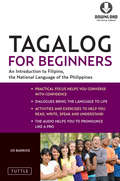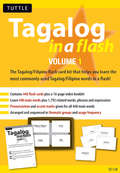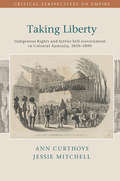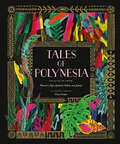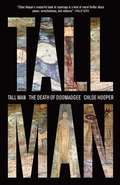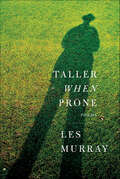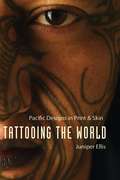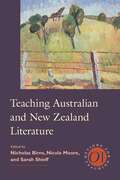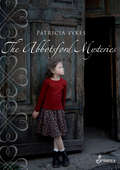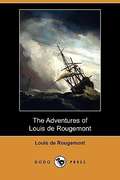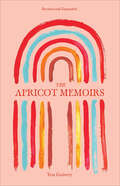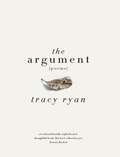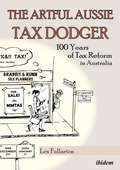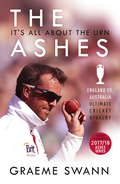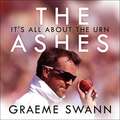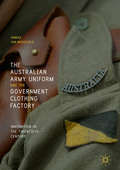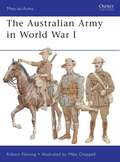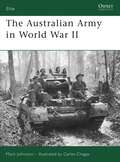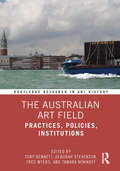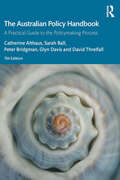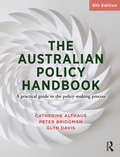- Table View
- List View
Tagalog for Beginners
by Joi BarriosThis is a straight-forward and user-friendly guide to the Tagalog language.Tagalog for Beginners is the book to help you learn Tagalog (Filipino) on your own, easily and accurately-whether you're traveling to the Philippines for a vacation or a business trip, or you have ties to the large Tagalog-speaking community in the U.S., or you're simply a language lover.From the fascinating history of Philippines' language to how you speak it, join skilled teacher Barrios on a guided introduction-with a practical focus. After journeying through the carefully-paced explanations, conversations, cultural info, and activities in Tagalog for Beginners, learners will be able to use Tagalog (Filipino) in a wide range of common situations. From shopping for food to asking directions, from telling time to expressing how you feel, this book gives you the communication skills you need. The MP3 audio-CD helps reinforce pronunciation and improve listening comprehension.Helpful suggestions guide heritage learners (those of Filipino descent but born outside the Philippines) on how to use the book most effectively for their needs.Key features include:: An accompanying MP3 Audio CD. Realistic dialogues to bring the language to life. Activities and exercises to help you read, write, speak and understand. Notes on the Tagalog language and history. A special section guides native (heritage) learners and instructors on how to use the book most effectively for their needs.
Tagalog in a Flash Volume 1
by Edwin LimTagalog in a Flash: Volume I is an excellent new language learning resource for beginning students of Tagalog.Tagalog is the national language of the Philippines, and the beloved language of the second-largest Asian-American ethnic group.<P><P>With a full range of features to help beginners and intermediate learners, Tagalog in a Flash Volume 1 is an excellent learning tool for anyone who wants to master Tagalog (also known as Filipino). Containing 448 flash cards of the most commonly used Tagalog words and phrases, along with sample sentences, handy indexes and a guide to using the cards for most effective learning, Tagalog in a Flash Volume 1 delivers.Contains 448 flash cars plus a 16 page index booklet.Learn 448 main words plus 1,792 related words, phrases and expressions.Pronunciation and accent marks given for all 448 main words.Arranged and sequenced in thematic groups and usage frequency.
Taking Liberty: Indigenous Rights and Settler Self-Government in Colonial Australia, 1830–1890 (Critical Perspectives on Empire)
by Ann Curthoys Jessie MitchellAt last a history that explains how indigenous dispossession and survival underlay and shaped the birth of Australian democracy. The legacy of seizing a continent and alternately destroying and governing its original people shaped how white Australians came to see themselves as independent citizens. It also shows how shifting wider imperial and colonial politics influenced the treatment of indigenous Australians, and how indigenous people began to engage in their own ways with these new political institutions. It is, essentially, a bringing together of two histories that have hitherto been told separately: one concerns the arrival of early democracy in the Australian colonies, as white settlers moved from the shame and restrictions of the penal era to a new and freer society with their own institutions of government; the other is the tragedy of indigenous dispossession and displacement, with its frontier violence, poverty, disease and enforced regimes of mission life.
Tales of Polynesia: Folktales from Hawai'I, New Zealand, Tahiti, and Samoa
by Yiling ChanguesExplore the enchanting world of Polynesian folklore in this beautifully illustrated collection of traditional stories.A woman falls in love with the king of the sharks. Two powerful sorcerers compete in a battle of magical wits. The king of Maui's fastest messenger races to bring a young woman back from the dead. In these traditional tales, the borders blur between life and death, reality and magic, and land and sea.This volume includes legends from Hawai'i, New Zealand, Tahiti, and Samoa, showcasing the rich narrative tradition of the Polynesian islands. You'll encounter awe-inspiring warriors, tricky magicians, and fearsome creatures of the deep. Each tale is paired with evocative contemporary art, creating a special illustrated edition to read, share, and treasure across generations. POPULAR SERIES: The Tales series gives new life to traditional stories. Celebrating the richness of folklore around the world, and featuring the work of beloved contemporary illustrators, these books are treasured by adults and teens alike.TALES THAT TRANSPORT YOU: These folktales are deeply rooted in the landscape of the Polynesian islands. Dramatic mountain peaks, secluded valleys, and mesmerizing ocean vistas offer striking settings for timeless stories of magic.GORGEOUS SPECIAL EDITION: With a mesmerizing full-page illustration for each story, as well as creamy paper, a ribbon page marker, and a handsome hardcover design, this edition is perfect for gifting and display.Perfect for:Adult, young adult, and teen fans of fairy tales, folklore, myths, legends, and historyReaders with Polynesian heritage or interested in Polynesian cultureIllustration and art loversCollectors of illustrated classics and such popular mythology books as D'Aulaires' Book of Greek Myths or Bulfinch's MythologyFans of MoanaFans of the illustrator Yiling Changues
Tall Man
by Chloe HooperEarly in 2005 Chloe Hooper was drawn into the bewildering and tragic case of Cameron Doomagee, an Aboriginal man on Australia's Palm Island, who died in police custody within one hour of his arrest. Like Joan Didion and Norman Mailer, Hooper brings a novelist's eye for detail and an acute understanding of character to this story. She explores the daily lives of these people, the role of the mythology and superstition, the impact of landscape, and the history of devastating repression, addiction and violence among the Aboriginal people. Hooper is brought to Palm Island by the lawyer representing Doomagee. She spends months garnering the trust of all involved. She recreates both the dramatic events of one morning and all the forces, "individual and historic" that led up to it. And then she chronicles the trial of the charismatic police Sergeant charged with manslaughter, "the first police office in Australia ever to be charged over a death in custody. This is an outstanding account of a landmark episode in Australian history, a searing story of racial conflict that will resonate with American readers.
Taller When Prone: Poems
by Les Murray"Les Murray has earned his reputation not only as one of Australia's finest writers but as one of the most engaging poets writing in English today." -Kate Kellaway, The Observer (London) Taller When Prone is Les Murray's first volume of new poems since The Biplane Houses, published in 2007. These poems combine a mastery of form with a matchless ear for the Australian vernacular. Many evoke rural life in Australia and elsewhere-its rhythms and rituals, the natural world, the landscape and the people who have shaped it. There are traveler's tales, elegies, meditative fragments, and satirical sketches. Above all, there is Murray's astonishing versatility, on display here at its exhilarating best.
Tamitha and the Troll Witch
by Elizabeth C. DesimoneEvery time Tamitha crosses the bridge, she is confronted by a troll-witch. Through magic, the troll-witch attempts to turn her into various creatures.
Tattooing the World: Pacific Designs in Print and Skin
by Juniper EllisIn the 1830s an Irishman named James F. O'Connell acquired a full-body tattoo while living as a castaway in the Pacific. The tattoo featured traditional patterns that, to native Pohnpeians, defined O'Connell's life; they made him wholly human. Yet upon traveling to New York, these markings singled him out as a freak. His tattoos frightened women and children, and ministers warned their congregations that viewing O'Connell's markings would cause the ink to transfer to the skin of their unborn children. In many ways, O'Connell's story exemplifies the unique history of the modern tattoo, which began in the Pacific and then spread throughout the world. No matter what form it has taken, the tattoo has always embodied social standing, aesthetics, ethics, culture, gender, and sexuality. Tattoos are personal and corporate, private and public. They mark the profane and the sacred, the extravagant and the essential, the playful and the political. From the Pacific islands to the world at large, tattoos are a symbolic and often provocative form of expression and communication.Tattooing the World is the first book on tattoo literature and culture. Juniper Ellis traces the origins and significance of modern tattoo in the works of nineteenth- and twentieth-century artists, travelers, missionaries, scientists, and such writers as Herman Melville, Margaret Mead, Albert Wendt, and Sia Figiel. Traditional Pacific tattoo patterns are formed using an array of well-defined motifs. They place the individual in a particular community and often convey genealogy and ideas of the sacred. However, outside of the Pacific, those who wear and view tattoos determine their meaning and interpret their design differently. Reading indigenous historiography alongside Western travelogue and other writings, Ellis paints a surprising portrait of how culture has been etched both on the human form and on a body of literature.
Teaching Australian and New Zealand Literature (Options for Teaching #40)
by Nicholas Birns Nicole Moore Sarah ShieffAustralia and New Zealand, united geographically by their location in the South Pacific and linguistically by their English-speaking inhabitants, share the strong bond of hope for cultural diversity and social equality--one often challenged by history, starting with the appropriation of land from their Indigenous peoples. This volume explores significant themes and topics in Australian and New Zealand literature. In their introduction, the editors address both the commonalities and differences between the two nations' literatures by considering literary and historical contexts and by making nuanced connections between the global and the local. Contributors share their experiences teaching literature on the iconic landscape and ecological fragility; stories and perspectives of convicts, migrants, and refugees; and Maori and Aboriginal texts, which add much to the transnational turn.This volume presents a wide array of writers--such as Patrick White, Janet Frame, Katherine Mansfield, Frank Sargeson, Witi Ihimaera, Christina Stead, Allen Curnow, David Malouf, Les Murray, Nam Le, Miles Franklin, Kim Scott, and Sally Morgan--and offers pedagogical tools for teachers to consider issues that include colonial and racial violence, performance traditions, and the role of language and translation. Concluding with a list of resources, this volume serves to support new and experienced instructors alike.
Tears of Mermaids: The Secret Story of Pearls
by Stephen G. BloomA round, luminescent pearl is the simplest and most perfect gem. Columbus sought—and found—this precious jewel coveted by his Spanish sovereigns, sparking popularity throughout Europe. Fashion icons Jacqueline Kennedy, Princess Grace, and Michelle Obama cherished them, making them iconic. And designer Coco Chanel raised them to new heights, bringing pearls— fake and real—to women everywhere. In Tears of Mermaids, Stephen G. Bloom travels 30,000 miles in an effort to trace a single pearl—from the moment a diver off the coast of Australia scoops an oyster containing a single luminescent pearl from the ocean floor to the instant a woman fastens the clasp of a strand containing the same orb. Bloom chronicles the never-before-told saga of the global pearl trade by gaining access to clandestine outposts in China, the Philippines, French Polynesia and Australia. He infiltrates high-tech pearl farms guarded by gun-toting sentries, farms for pearls in rural China, and even goes backstage at Christie's for a fast and furious auction of the most expensive pearl ever sold. Teeming with rogue humor and uncanny intelligence, Tears of Mermaids weaves a nonstop detective story whose main character is the world's most enduring jewel.
The Abbotsford Mysteries
by Patricia SykesThe Abbotsford Convent becomes more than the setting of this poetry collection; it emerges as presence, intimate and familiar as well as constraining and forbidding. But, it is childhood itself that becomes the subterranean geography and pulse of this compilation as the poems explore what it means to grow up in an orphanage. Subject to the rules of lay and religious adults, the voices herein create multiple pathways through memory and time as they map and navigate the many-stranded mysteries of their institutionalized lives.
The Adventures of Louis de Rougemont
by Louis De RougemontLouis de Rougemont (1847-1921) was a would-be explorer who claimed to have had adventures in Australasia. "de Rougemont" was born Henri Louis Grin in 1847 in Suchy, Switzerland. <P> <P> In 1898 he began to write about his invented adventures in the British periodical The Wide World Magazine under the name Louis de Rougemont. He described his alleged exploits in search of pearls and gold in New Guinea and claimed to have spent thirty years living with Indigenous Australians in the Australian outback. He claimed that the tribe with whom he had lived had worshipped him as a god. He also claimed to have encountered the Gibson expedition of 1874. Various readers expressed disbelief in his tales from the start, for example, claiming that no one can actually ride a turtle. He had also claimed to have seen flying wombats. The fact that he could not place his travels on the map aroused suspicion. Readers' arguments in the pages of London newspaper, the Daily Chronicle, continued for months.
The Apricot Memoirs
by Tess GuineryWhat started as a break from Australian artist Tess Guinery&’s rapidly growing design business turned into an instinctive, playful experiment with words, colors, and sounds—and eventually into a tangible book, The Apricot Memoirs.This collection of poetry and prose, thoughtfully illustrated and printed on colored paper, is infused with grace and playfulness. It explores love, personal growth, creativity, spirituality, vulnerability, and motherhood in the art medium of words, all the while creating a rich portrait of a deeply empathetic, talented, and whimsical artist. Esoteric, mysterious, and unfailingly beautiful, The Apricot Memoirs is an invitation to dig deep, embrace the uncomfortable, and free your creativity, unbound.
The Argument
by Tracy RyanPoems of keen appraisal and survival, bound by a cohesive vision, form this collection, which features the work of Australian poet Tracy Ryan. Revealing the poet's preoccupation with mortality, this compilation deals with the cold cross-examiner death by responding with life.
The Artful Aussie Tax Dodger: 100 Years of Tax Reform in Australia
by Lex FullartonIn The Artful Aussie Tax Dodger, Lex Fullarton studies the impact of 100 years of taxation legislation in Australia, from 1915 to 2016. He finds that despite the lessons of a century of taxpayers and administrators' actions and reactions, old habits are hard to break. Driven by the winds of various political and social interests, Australia embarked on a century of tax reform from the moment when its first Income Tax Assessment Act was introduced. <P><P>Fullarton discusses the oldest of tax planning entities, the British Trust, the introduction of Australia's 'reformed' consumption tax, its VAT, referred to as Goods and Services Tax, an analysis of tax avoidance schemes, and finally government taxation reform. This book looks at how Australia's tax legislation was grounded, added to, avoided, and evolved, until it went 'Back to the Future'. It is a collection of studies compiled from experience and research conducted over twenty years of involvement in taxation law in rural and remote Australia.
The Ashes: England vs. Australia: ultimate cricket rivalry
by Graeme SwannShortlisted for Cricket Book of the Year at the British Sports Book AwardsGraeme Swann leads us on a compelling adventure through one of world sport's most engrossing rivalries. He knows as much as anybody about the heat of England v Australia battles, having played in three series wins and also the whitewash defeat of 2013-14 when its intensity ended his international career. However, it brought out some of his best displays in Test cricket. But he is just one of dozens of colourful characters to have added their chapters to this great tome. The mock obituary of English cricket in the Sporting Times of 1882 was the forerunner of summers and winters of heaven and hell, depending on which side of the divide you were situated. When it comes to on-field relations nothing quite compares to the over-my-dead-body feel of the Ashes.From Grace to Sir Don, the most graceful of them all. From the foulest play to the fairest - contrast the 1932-33 Bodyline series affair to the image of Andrew Flintoff hunched over a distraught Brett Lee in 2005. From Ray Illingworth's famous walk-off in the Seventies, when an England team-mate was assaulted by a spectator, to Steve Waugh's hugely emotional lap of honour when he retired a quarter of a century later. Swann's book will reveal the magic of a series that first gripped him in his front room in Northampton as an aspiring spin bowler in the mid-1980s.
The Ashes: England vs. Australia: ultimate cricket rivalry
by Graeme SwannGraeme Swann leads us on a compelling adventure through one of world sport's most engrossing rivalries. He knows as much as anybody about the heat of England v Australia battles, having played in three series wins and also the whitewash defeat of 2013-14 when its intensity ended his international career. However, it brought out some of his best displays in Test cricket. But he is just one of dozens of colourful characters to have added their chapters to this great tome. The mock obituary of English cricket in the Sporting Times of 1882 was the forerunner of summers and winters of heaven and hell, depending on which side of the divide you were situated. When it comes to on-field relations nothing quite compares to the over-my-dead-body feel of the Ashes.From Grace to Sir Don, the most graceful of them all. From the foulest play to the fairest - contrast the 1932-33 Bodyline series affair to the image of Andrew Flintoff hunched over a distraught Brett Lee in 2005. From Ray Illingworth's famous walk-off in the Seventies, when an England team-mate was assaulted by a spectator, to Steve Waugh's hugely emotional lap of honour when he retired a quarter of a century later. Swann's book will reveal the magic of a series that first gripped him in his front room in Northampton as an aspiring spin bowler in the mid-1980s.
The Ashes: ultimate cricket rivalry
by Graeme SwannGraeme Swann leads us on a compelling adventure through one of world sport's most engrossing rivalries. He knows as much as anybody about the heat of England v Australia battles, having played in three series wins and also the whitewash defeat of 2013-14 when its intensity ended his international career. However, it brought out some of his best displays in Test cricket. But he is just one of dozens of colourful characters to have added their chapters to this great tome. The mock obituary of English cricket in the Sporting Times of 1882 was the forerunner of summers and winters of heaven and hell, depending on which side of the divide you were situated. When it comes to on-field relations nothing quite compares to the over-my-dead-body feel of the Ashes.From Grace to Sir Don, the most graceful of them all. From the foulest play to the fairest - contrast the 1932-33 Bodyline series affair to the image of Andrew Flintoff hunched over a distraught Brett Lee in 2005. From Ray Illingworth's famous walk-off in the Seventies, when an England team-mate was assaulted by a spectator, to Steve Waugh's hugely emotional lap of honour when he retired a quarter of a century later. Swann's book will reveal the magic of a series that first gripped him in his front room in Northampton as an aspiring spin bowler in the mid-1980s.
The Australian Army Uniform and the Government Clothing Factory: Innovation In The Twentieth Century
by Anneke Van MosseveldThis book reveals the business history of the Australian Government Clothing Factory as it introduced innovative changes in the production and design of the Australian Army uniform during the twentieth century. While adopting a Schumpeterian interpretation of the concept of innovation, Anneke van Mosseveld traces the driving forces behind innovation and delivers a comprehensive explanation of the resulting changes in the combat uniform. Using an array of archival sources, this book displays details of extensive collaborations between the factory, the Army and scientists in the development of camouflage patterns and military textiles. It uncovers a system of intellectual property management to protect the designs of the uniform, and delivers new insights into the wider economic influences and industry linkages of the Government owned factory.
The Australian Army in World War I
by Robert Fleming Mike ChappellThe Australian contribution to the Allied war effort during World War I is worthy of celebration. Some 400,000 Australians volunteered for active duty, an astonishing 13 per cent of the entire (white) male population, a number so great that the Australian government was never forced to rely on conscription. Casualties were an astonishing 52 per cent of all those who served, ensuring that the effects of the war would be felt long after the armistice. In particular, their epic endeavours at Gallipoli in 1915 became the nation's founding legend, and the ANZACs went on to distinguish themselves both on the Western Front, and in General Allenby's great cavalry campaign against the Turks in the Middle East. Their uniforms and insignia were also significantly different from those of the British Army and will provide the inspiration for a unique set of artwork plates.
The Australian Army in World War II
by Mark Johnston Carlos ChagasOsprey's examination of the Australian army and its involvement in World War II (1939-1945). The Australian infantry were amongst the Commonwealth's toughest and most widely traveled infantry, serving in campaigns including Syria, Greece, Cyprus, Crete, Libya, Egypt, New Guinea, and the South West Pacific. Their fearsome fighting reputation was earned first against the Afrika Corps in the Libyan Desert, and then in the hellish conditions of New Guinea, where they held out against the Japanese invasion.Written by a leading expert on the subject and coupled with previously unpublished photographs from private collections and specially commissioned artwork, this book gives a comprehensive overview of the organization, units, uniforms, and insignia of the Australian "Diggers."
The Australian Art Field: Practices, Policies, Institutions (Routledge Research in Art History)
by Tony Bennett Deborah Stevenson Fred Myers Tamara WinikoffThis book brings together leading scholars and practitioners to take stock of the frictions generated by a tumultuous time in the Australian art field and to probe what the crises might mean for the future of the arts in Australia. Specific topics include national and international art markets; art practices in their broader social and political contexts; social relations and institutions and their role in contemporary Australian art; the policy regimes and funding programmes of Australian governments; and national and international art markets. In addition, the collection will pay detailed attention to the field of indigenous art and the work of Indigenous artists. This book will be of interest to scholars in contemporary art, art history, cultural studies, and Indigenous peoples.
The Australian Policy Handbook: A Practical Guide to the Policymaking Process
by Glyn Davis Sarah Ball Catherine Althaus Peter Bridgman David ThrelfallThe seventh edition of this classic handbook on the policy process is fully updated, featuring new material on policy making amid local and global disruption, the contestable nature of modern policy advice, commissioning and contracting, public engagement and policy success and failure. The Australian Policy Handbook shows how public policy permeates every aspect of our lives. It is the stuff of government, justifying taxes, driving legislation and shaping our social services. Public policy gives us roads, railways and airports, emergency services, justice, education and health services, defence, industry development and natural resource management. While politicians make the decisions, public servants provide analysis and support for those choices. This updated edition includes new visuals and introduces a series of case studies for the first time. These cases—covering family violence, behavioural economics, justice reinvestment, child protection and more—illustrate the personal and professional challenges of policymaking practice. Drawing on their extensive practical and academic experience, the authors outline the processes used in making public policy. They systematically explain the relationships between political decision makers, public service advisers, community participants and those charged with implementation. The Australian Policy Handbook remains the essential guide for students and practitioners of policy making in Australia.
The Australian Policy Handbook: A practical guide to the policy making process
by Glyn Davis Catherine Althaus Peter BridgmanPublic policy permeates every aspect of our lives. It is the stuff of government, justifying taxes, driving legislation, and shaping our social services. Public policy gives us roads, railways and airports, emergency services, industry development, and natural resource management. While politicians make the decisions, public servants provide analysis and support for those choices.Drawing on their extensive practical experience, the authors outline the processes used in making public policy. They systematically explain the relationships between political decision-makers, public service advisers, other community participants, and those charged with implementing the programs that result.The sixth edition of this widely used introduction is fully updated, and includes new material on the professionalisation of politicians, the role of opposition members, loss of corporate memory in the public service, addressing systemic policy failure, nudge economics and the impact of social media and the sharing economy on policy making and government.'An invaluable guide for practitioners, academics and students to the craft of policy analysis, development and evaluation. It is an important resource for those with a commitment to sound evidence-based public policy.'Ken Smith, ANZSOG CEO and Dean 'An enduring and important contribution to the field. Althaus, Bridgman and Davis' pioneering policy cycle approach continues to offer vital insights into the policy-making process in Australia and internationally.'Lisa Paul AO PSM, Former Secretary of the Department of Education
The Australian Political System in Action
by Narelle Miragliotta Wayne Errington Nicholas BarryThe Australian Political System in Action blends practical (detailed examination of politics institutions) with theoretical (explanations of theory and its application). It does this by sectioning each chapter into two parts. The first provides a comprehensive overview of the political institution under examination (form, function and nature), using plenty of real-world of examples and discussion of comparative political systems to interest students. Part two investigates a contemporary issue relevant to the particular institution, again using lots of examples. This section links the practical elements to the broader theoretical framework and encourages students to delve deeper into the topics and the issues and debates that surround them.
